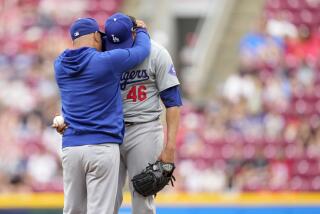A Way of Life
- Share via
PITTSBURGH — For Toby Petersen, the regimen is as much a part of life as sharpening skates or sanding hockey sticks. It is the only way he can play in the NHL, the only way he can step onto the ice and see Mario Lemieux on his line.
There is another reason, too: It is the only way he can live.
Every day, Petersen pricks a finger with a needle six, seven, eight times to get a blood-sugar reading. When he plays a game, he does it between every period.
Then, as if that wasn’t hard enough, there are the insulin shots he needs up to six times daily. Altogether, he sticks a needle into his arm, shoulder or finger 14 times a day -- not just every day he plays hockey, but every day of his life.
Petersen, you see, isn’t just a rookie forward for one of hockey’s most gifted offensive teams, the Pittsburgh Penguins. Or a scorer talented enough that he played on Lemieux’s line when Lemieux was healthy. Or a player who can now laugh at the critics who thought a 5-foot-9 forward picked in the ninth round of the draft couldn’t play in the NHL.
Petersen also is a diabetic.
He is not the first athlete to achieve success while fighting a disease that not only changes a person’s daily routine, but can blind, disable or kill. The disease, in which the body destroys its own insulin-producing cells in the pancreas, affects about 16 million Americans, and one dies every three minutes of every day.
“To me, it’s something I’ve grown accustomed to and come to live with, so I don’t really fight it or shake my head and say I don’t want to do this anymore,” Petersen said at the end of an exhaustive practice. “It’s part of my life. I wake up in the morning and I don’t fight it, it’s part of my routine and I’ve got to keep doing it.”
Former Philadelphia Flyers star Bobby Clarke, now the team’s general manager, also has diabetes. So does Olympic swimmer Gary Hall Jr., former NFL quarterback Wade Wilson and Portland Trail Blazers center Chris Dudley. Detroit Pistons star Jerry Stackhouse became a spokesman for the National Diabetes Education Program after two sisters died of the disease.
The alternative to not treating diabetes is ... well, there is no alternative.
“It’s a hassle, it really is,” the 23-year-old Petersen said. “But I’ve already had people come up to me and say they think it’s great that I’m able to play at this level while fighting the disease. That kind of keeps me going, to know that people are looking up to me and looking to me for inspiration.”
They did that in his hometown of Bloomington, Minn., too, where he began playing hockey about the same time he started elementary school, begging his parents to ignore doctor’s suggestions to reduce his around-the-clock involvement in sports.
He was an inspiration, too, at Colorado College, where he broke both legs during his junior season.
Remarkably, he returned to play his senior season, get his degree in psychology, get drafted and, a year later, lead the Penguins’ Wilkes-Barre-Scranton (AHL) team in scoring with 26 goals and 67 points in 73 games. He also played briefly for the Penguins last season, getting two goals in December before returning to the minors when Lemieux came out of retirement.
Then, after sweating out a training camp in which he didn’t know if he would make the roster, he was moved onto Lemieux’s line when Rick Kehoe became the coach.
His highlight was scoring three goals Oct. 16 against Ottawa in Kehoe’s first game as coach -- coincidentally, his only goals in his first full month in the league.
Lemieux, who knows something about overcoming a potentially deadly disease after being diagnosed with Hodgkin’s disease eight years ago, admires Petersen’s courage and perseverance, as do his other teammates.
“The kid’s got a lot of heart, and you can tell how much he loves the game,” Penguins forward Kevin Stevens said.
Kehoe likes how Petersen complemented Lemieux when the two were playing together before Lemieux injured his hip.
“He moves real well, and that’s good for Mario. You can see there’s some chemistry there,” Kehoe said.
For now, Petersen is preoccupied with overcoming his size disadvantage and finding a way to beat NHL goalies.
And, as always, there are periodic reminders of the diabetes. He became faint after an Oct. 22 practice, with the problem traced to a drop in his blood-sugar level that was quickly corrected.
Because of all he goes through to play, Petersen speaks to youth groups and other organizations to spread the word that while he has diabetes, he can play a physically demanding sport at a very high level.
“It’s something that I’m combatting every day. That’s why I’m working as hard as I can living with it,” Petersen said. “You’ve got to fight it, control it. I don’t have any other choice.”
More to Read
Go beyond the scoreboard
Get the latest on L.A.'s teams in the daily Sports Report newsletter.
You may occasionally receive promotional content from the Los Angeles Times.






